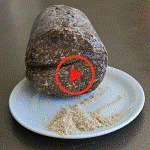
Carbohydrate from Wikipedia: https://en.m.wikipedia.org/wiki/Carbohydrate
===Introduction===
A carbohydrate (/kɑːrboʊˈhaɪdreɪt/) is a biomolecule consisting of carbon (C), hydrogen (H) and oxygen (O) atoms, usually with a hydrogen–oxygen atom ratio of 2:1 (as in water) and thus with the empirical formula Cm(H2O)n (where m may be different from n). This formula holds true for monosaccharides. Some exceptions exist; for example, deoxyribose, a sugar component of DNA,[1] has the empirical formula C5H10O4.[2] The carbohydrates are technically hydrates of carbon; structurally it is more accurate to view them as aldoses and ketoses.
The term is most common in biochemistry, where it is a synonym of “saccharide”, a group that includes sugars, starch, and cellulose. The saccharides are divided into four chemical groups: monosaccharides, disaccharides, oligosaccharides, and polysaccharides. Monosaccharides and disaccharides, the smallest (lower molecular weight) carbohydrates, are commonly referred to as sugars.[3] The word saccharide comes from the Greek word σάκχαρον (sákkharon), meaning “sugar”.[4] While the scientific nomenclature of carbohydrates is complex, the names of the monosaccharides and disaccharides very often end in the suffix -ose, as in the monosaccharides fructose (fruit sugar) and glucose (starch sugar) and the disaccharides sucrose (cane or beet sugar) and lactose (milk sugar).
Carbohydrates perform numerous roles in living organisms. Polysaccharides serve for the storage of energy (e.g. starch and glycogen) and as structural components (e.g. cellulose in plants and chitin in arthropods). The 5-carbon monosaccharide ribose is an important component of coenzymes (e.g. ATP, FAD and NAD) and the backbone of the genetic molecule known as RNA. The related deoxyribose is a component of DNA. Saccharides and their derivatives include many other important biomolecules that play key roles in the immune system, fertilization, preventing pathogenesis, blood clotting, and development.[5]
They are found in a wide variety of natural and processed foods. Starch is a polysaccharide. It is abundant in cereals (wheat, maize, rice), potatoes, and processed food based on cereal flour, such as bread, pizza or pasta. Sugars appear in human diet mainly as table sugar (sucrose, extracted from sugarcane or sugar beets), lactose (abundant in milk), glucose and fructose, both of which occur naturally in honey, many fruits, and some vegetables. Table sugar, milk, or honey are often added to drinks and many prepared foods such as jam, biscuits and cakes.
Cellulose, a polysaccharide found in the cell walls of all plants, is one of the main components of insoluble dietary fiber. Although it is not digestible, insoluble dietary fiber helps to maintain a healthy digestive system[6] by easing defecation. Other polysaccharides contained in dietary fiber include resistant starch and inulin, which feed some bacteria in the microbiota of the large intestine, and are metabolized by these bacteria to yield short-chain fatty acids.[7][8]
===Contents===
Terminology
Structure
Division
Monosaccharides
Classification of monosaccharides
Ring-straight chain isomerism
Use in living organisms
Disaccharides
Nutrition
Classification
Health effects of dietary carbohydrate restriction
Metabolism
Catabolism
Carbohydrate chemistry
See also
Video Rating: / 5





























































